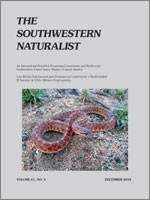In the Western Breeding Bird Survey Region, and in Colorado, breeding populations of the western wood-pewee (Contopus sordidulus) have decreased, and with global climate change their breeding range is predicted to decrease during this century. In addition, their breeding biology has not been commonly studied. From 1992–1998 and in 2001 and 2004, we studied the breeding biology and nest survival of this species in southwestern Colorado. During our study, timing of clutch initiation for the first seven nests within a breeding season advanced significantly earlier in the year from 14 June 1992 to 4 June 2004. Clutch size was typically three eggs that resulted in 2.48 (±0.08) fledglings from successful nests. Parasitism by brown-headed cowbirds (Molothrus ater) was infrequent with ∼5% of nests parasitized, but no parasitic young successfully fledged. Using Program MARK, the most-supported models to describe nest survival (n = 114 nests) in western wood-pewees used a varying daily survival rate during the breeding season along with some combination of the three covariates of year, the ratio of nest height to substrate (nest tree) height, and substrate (nest tree) height. Nest survival decreased with the breeding season. Also, nest concealment (determined in 1998, 2001, and 2004) was not significantly different between successful and unsuccessful nests of western wood-pewees.
How to translate text using browser tools
1 December 2016
Contributing variables to nest survival, and the breeding biology, of the Western Wood-Pewee (Contopus sordidulus) in southwestern Colorado
Joseph C. Ortega,
Catherine P. Ortega
ACCESS THE FULL ARTICLE

The Southwestern Naturalist
Vol. 61 • No. 4
December 2016
Vol. 61 • No. 4
December 2016




